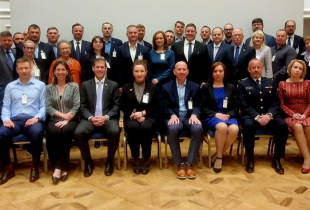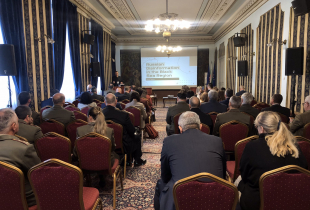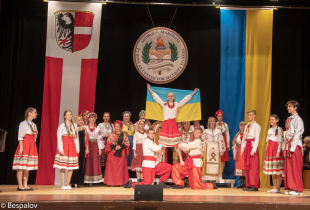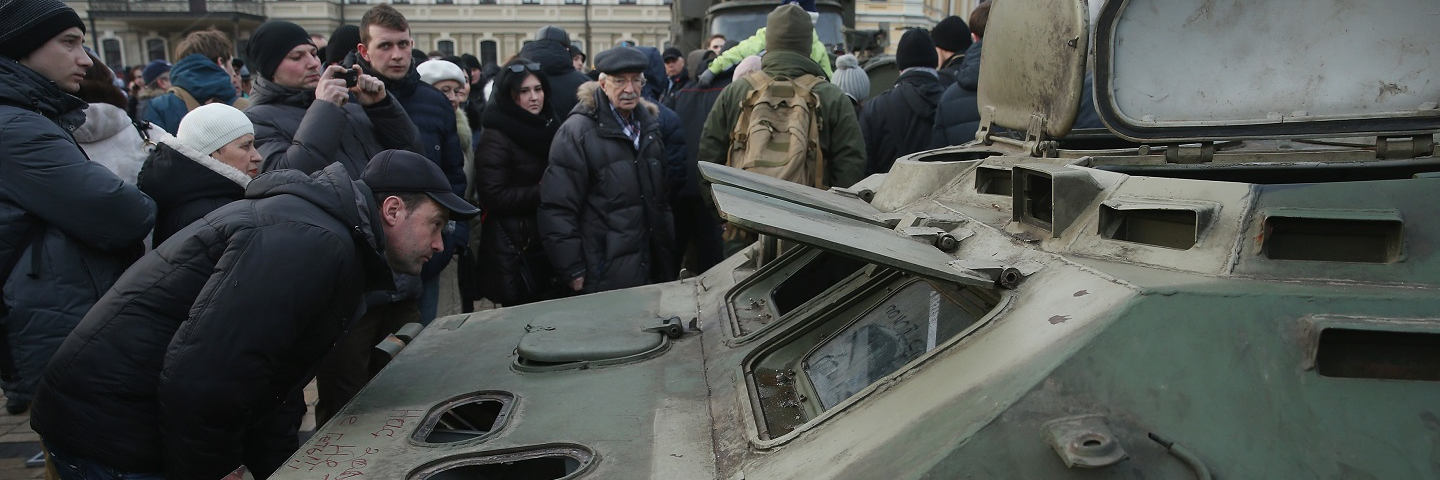
Russia’s “Strategic Deterrence” in Ukraine
Executive Summary
- During a year of critical presidential and parliamentary elections in Ukraine, the risk of instability remains high, but a major military offensive by Russia is unlikely. Russian policy can be interpreted as a form of “strategic deterrence,” in which Moscow seeks to achieve its goals in Ukraine through a policy of active containment and strategic patience while avoiding overt military conflict.
- In current Russian usage, “strategic deterrence” is the use of both military and non-military means to prevent strategic gains by an opponent. It combines military means short of the use of force, such as an aggressive military build-up, with non-military tactics, including diplomacy, peace negotiations, information warfare, and political tactics. This strategy has allowed Russia to consolidate control of the Crimean peninsula, the Donbas region, and the Kerch Strait with only limited use of regular military forces.
- In the longer term, however, the strategic deterrence mindset poses problems for Russia. First, it escalates every local conflict in Russia’s borderlands into a high-level strategic game between Russia and the West, ensuring a long-term crisis in Moscow’s relations with the West, and limiting Russia's influence inside Ukraine. Second, instead of resolving conflicts, it produces militarized, stalemate-prone outcomes, leaving Russia entangled in a belt of semi-frozen conflicts around its borders.
After five years of war in the Donbas, with a death toll over 13,000, prospects for a peace deal have faded.1 Tensions have risen in the run-up to critical presidential elections in March 2019 and parliamentary elections in October 2019. Ukrainian officials have warned of a possible Russian offensive, pointing to a military build-up along Ukraine’s borders, the seizure of Ukrainian vessels in the Kerch Strait, and an upsurge in anti-Ukrainian rhetoric in Russian official media. In reality, a Russian land invasion is unlikely. Moscow’s policy can be interpreted as “strategic deterrence,” which aims to avoid any escalation of the armed conflict in eastern Ukraine, while continuing to use information campaigns and political tools to try to weaken Ukraine from within.
Referring to Russian policy as strategic deterrence may appear counterintuitive. Russia has annexed the Crimean peninsula, fueled a separatist war in Ukraine’s Donbas region, and deployed a powerful land army along the entire length of the border between Ukraine and Russia. On November 25, 2018, Russian border guards seized three Ukrainian naval vessels and detained twenty-four sailors after blocking their passage through to the Sea of Azov. An understanding of Russia’s concept of strategic deterrence helps to explain why such actions, which are viewed in the West as aggressive and destabilizing, can be interpreted in Moscow as essentially defensive and aimed at preventing conflict.
As defined by the Russian Military Encyclopedia, strategic deterrence is a “coordinated system of military and non-military measures, adopted sequentially or simultaneously … with the aim of constraining [an opponent] from any use of force, which [..] entails or threatens to entail damage on a strategic scale.”2 It is a concept that is grounded in—and continues to emphasize—traditional ideas of nuclear deterrence and also includes the use of conventional military force.3 But central to Russia’s contemporary understanding of deterrence are such non-military tactics as diplomacy, peace talks, “information warfare,” and politics.4
This emphasis on non-military tactics highlights similarities with the more common—but now highly politicized—concept of “hybrid war.”5 But strategic deterrence provides better insights into Russia’s current worldview, which characterises Russia as on the defensive against an expansionist campaign by the West. In this view, the United States and its allies have surrounded Russia with several concentric, tightening circles of containment—the “coils of the Anaconda,” as one recent article put it.6 The North American Treaty Organization (NATO) is the military instrument of this policy, deliberately fomenting what Russian analysts refer to as “managed chaos” [upravlyaemyi khaos] along Russia’s borders, using economic sanctions, “color revolutions” and information warfare, with the aim of ultimately challenging Russian statehood and sovereignty.
At times, Russia has responded to this perceived strategic threat with a policy of fragmentation and chaos, a set of “destabilization policies” that aim to undermine pro-Western, pro-NATO governments.7 But where Russia is in a position of strength, or wants to consolidate strategic gains, its preferred option is not chaos, but the imposition of order—on Russian terms. It uses strategic deterrence “to prevent the use of force” by an opponent, to contain an opponent “within certain limits,” and to “deescalate a military conflict.”8 Russia’s approach can be considered a form of active containment, which seeks to shape the strategic environment so that Russia can gain its strategic goals without having to resort to the use of force.
In strategic deterrence theory, the active use of full-scale military force is a last resort, to be deployed only when deterrence has failed. A recent editorial in the Russian military journal, Voennaya Mysl’ [Military Thought], points to a growing belief that “to fight on the battlefield is the work of those who fail at politics and strategy.” Conquering territory, in this view, is “a burden, which drains resources and limits freedom of action.”9 It is viewed as much better to achieve strategic goals through such non-military means as smart diplomacy, covert actions, political machinations, and information warfare.
Ukraine: The Logic of Strategic Deterrence
Russia’s interpretation of the conflict in Ukraine fits easily into this world view. Russia characterises the conflict as a civil war, provoked by a Western-backed coup d’etat in 2014. The government is considered a U.S.-backed puppet regime, which has, in Foreign Minister Sergei Lavrov’s phrase, “Nazi and neo-Nazi characteristics” and is intent on expanding NATO up to the Russian frontier.10 In this way, whatever the local dynamics of the conflict, the Russian leadership has consistently characterised it as a strategic threat against which Moscow invokes the different mechanisms of strategic deterrence. As if to underline that point, President Vladimir Putin claims to have considered placing Russian strategic nuclear forces on alert during the 2014 crisis on the Crimean peninsula.11
Misleading threat assessments in Moscow produce Russian government policy responses that are often prone to misinterpretation. A week after the naval clash in the Kerch Strait in November 2018, Ukrainian President Petro Poroshenko warned of a Russian plan to force a land corridor across Ukrainian territory from Donbas to Crimea through the strategic port of Mariupol.12General Viktor Muzhenko, commander of Ukraine’s armed forces, claimed that the military threat from Russia was at its highest since 2014.13 Analysts at the U.S.-based Institute for the Study of War echoed these warnings, concluding that the Russian military was actively preparing for military operations in Ukraine.14
In Russia, President Putin’s spokesman dismissed Poroshenko’s claims of an imminent invasion as “absurd,” and accused Ukraine of provoking tensions.15 Lavrov warned that it was the Ukrainian government, not Russia, that was planning a “military provocation” on the border with Crimea.16 In this scenario, Poroshenko, who is running on the uncompromising campaign slogan of “Army, Language, Faith,” in the March presidential elections, was planning a military offensive to bolster his lagging poll ratings with an appeal to Ukrainian patriotism.17 If he tries anything, warned Lavrov, “he’ll receive an answer, and not a small one.” 18
A Ukrainian offensive was always highly unlikely, but there seems to have been a genuine belief in Moscow that a “wag the dog”-style attack was possible. Rather than get drawn into an armed conflict, strategic deterrence proposes a wide range of military tactics, short of the use of force, to deter any such provocations. Suggested tactics include “the demonstration of military presence and military force;” “the protection and defence of the state border in the air, on land and on sea;” “a demonstrative transfer of forces from a peace to a war footing;” or а “substantial build-up (deployment) of groups (of forces).”19
Throughout 2018, Russia carried out exactly these types of military manoeuvres around Crimea and along Ukraine’s borders. The media has been full of blurred photographs of hundreds of tanks conveniently parked, en masse, for satellites to capture, although many of them appear to be obsolete.20 Data pointing to a military build-up can easily be misread as the precursor to a major offensive, but the build-up is much more likely to be a deterrence mechanism, aiming to deter any attempt by the Ukrainian military to recapture the Donbas by force, inevitably dragging Russia into a dangerous open conflict. As one Russian newspaper phrased it: “The Russian group [of forces] is being deployed to pacify the aggressor, who is attempting by military means to destroy the unrecognized republics of Donbass.”21 According to the chief of the general staff, General Valery V. Gerasimov, the military build-up was designed to counter any “provocations” by “unfriendly forces,” and to “guarantee security.”22
Strategic deterrence aims to constrain not only the actions of an enemy, but also of allies and proxies. Backing a separatist movement in the Donbas helped Russia maintain the fiction of noninvolvement, but also created risks and vulnerabilities. Moscow quickly stamped on any signs of autonomy among leaders of the self-declared Donetsk and Luhansk “People’s Republics” (DNR/LHR) that emerged in the Donbas. These efforts were sometimes aided by the untimely deaths of numerous Donbas leaders.23 Russia promoted new, more pliant elites in their place, answerable to Moscow’s curators and not the local population. These new elites in the Donbas have taken over lucrative sectors of the economy for their own benefit though corporate raiding and the nationalization of industries, making them reluctant to lose their newfound wealth and status and therefore relatively easy for Moscow to manage.24
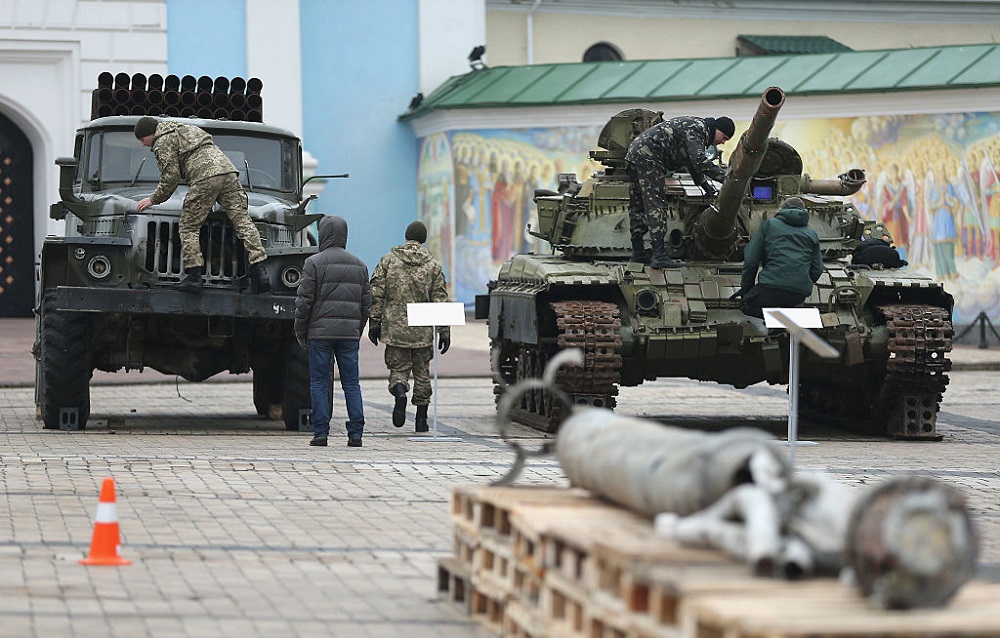
Peace Talks and Diplomacy
Military dominance and control of proxies ensures command of the strategic environment, within which other non-military instruments can be deployed. Strategic deterrence includes the “conduct of negotiations through diplomatic channels” and “initiatives to strengthen inter-state relations” as part of a holistic approach to strategic thinking. 25 Peace talks and diplomacy play an important role—not as alternatives to military activities, but as complementary policy options to achieve the same strategic goals.26
Russia has repeatedly used peace negotiations around Ukraine to consolidate its strategic gains and to normalize its de facto control of Crimea, the Sea of Azov, and the Donbas. The two Minsk Agreements of September 2014 and February 2015 achieved vital ceasefires, but on terms that were largely advantageous to Moscow and thus have consequently never been implemented in full by Kiev27. The Minsk accords also further institutionalized the DNR and LNR, abetted by a policy of isolation pursued by Kiev; embedded local elites; and encouraged a Donbas identity project that threatens to make long-term reintegration more difficult.28
More recently, after the November 25 seizure of Ukrainian ships, Russia rejected a German proposal to extend the mandate of the Organisation for Security and Cooperation in Europe (OSCE) monitoring mission in Donbas to the Sea of Azov and the Kerch Straits, but invited French and German experts on a limited one-time monitoring visit. This initiative excluded Ukraine and risked providing tacit international recognition of Russia’s de facto control over the strait, prompting European Union diplomats to backtrack.29
The 2018 discussions of a possible United Nations (UN) peacekeeping force in the Donbas followed a similar logic. A September 2017 Russian proposal for UN peacekeeping forces to be deployed in Eastern Ukraine envisaged a lightly armed force to accompany OSCE monitors along the front line between the two sides. Western and Ukrainian diplomats responded with a proposal to extend UN peacekeeping troops across the entire territory of the DNR and LNR, including the Ukrainian-Russian border, while installing a civil administration to oversee security and new elections.30
Such a maximalist proposal was unacceptable to Russia, concerned that a UN administration “may create conditions for a unilateral resolution of the conflict by force on the part of Kyiv.”31 Lavrov views a powerful UN administration in the region as potentially “turning into a military-political commandant’s office, which will take the entire territory of the self-proclaimed republics ... and will decide for itself whom to elect and how to elect.”32
There has been a rush of think-tank reports trying to narrow the gap between these two visions of peacekeeping. But the two positions do not just differ in policy nuance that can be overcome by clever diplomacy. In the Western view, peacekeeping is a route to resolving an internal conflict and producing a just peace. Russian thinking on strategic deterrence views peacekeeping as primarily an instrument for managing and controlling a conflict for strategic advantage. Bridging this conceptual gap may prove insurmountable.
Politics and Information Warfare
The Russian military views information warfare as central to effective strategy, to be used as “a crisis management tool that can prevent aggression without direct employment of military force.”33 Information war is not simply the production of fake news, but about something much deeper—a war of meanings, a struggle over fundamental concepts and the interpretation of events.34 At its most basic, the two sides struggle over the interpretation of the conflict: for Russia, it is an internal Ukrainian civil war; Ukraine considers it “a proxy war by Russia,” in which the separatist authorities are defined by law as “the Russian occupational administrations.”35
Opinion polls suggest that Russia is losing this war of meanings in Ukraine: 80 percent of those polled agree that “Russia is the aggressor country, which has illegally annexed Crimea and is leading an ongoing aggression against Ukraine,” and over 70 percent believe that “[t]he goal of the current regime in Russia is to destroy Ukraine’s independence and sovereignty.”36
Nevertheless, these headline figures disguise a complex political landscape. Political shifts are always possible in a country where 70 percent of citizens believe that “things in Ukraine are going in the wrong direction.37 Popular discontent, primarily over the economy and high-level corruption, offers fertile ground for more populist candidates, such as comedian actor Volodymyr Zelenski, a front-runner in the March presidential elections, and who may be open to a more accommodating policy towards Russia.38
But Russia lacks creative ideas on how to reshape the political-informational space in its favour, still relying on President Putin’s closest Ukrainian friend, oligarch Viktor Medvedchuk, to marshal pro-Russian forces through his media outlets and at elections. Medvedchuk is leading the Opposition Platform-For Life coalition, but its presidential candidate, Yuri Boiko, is struggling to reach 10 percent in opinion polls; a smart campaign by Zelenski could take away some of his potential voters.39
More covert political initiatives have also proved unsuccessful for Russia. Plans by Russian hardliners for a Bosnia and Herzegovina model for Ukraine, involving the effective breakup of the country into culturally distinct zones, now appear far-fetched.40 Russian speakers in the east and south and small Hungarian and Romanian minorities in western Ukraine have proved resistant to any covert mobilization by Moscow, despite a divisive education bill passed in 2017 that restricted minority-language education. Even in the breakaway republics, polls suggest a majority would prefer to remain as part of Ukraine.41
Conclusion
Rather than interpreting Russia as always on the verge of a new military offensive, strategic deterrence helps to understand Russian policy as a form of active containment, which entails both offensive and defensive logic. Russia uses all military measures, short of the use of force, to contain the conflict in the Donbas, controlling its own proxies and deterring any offensive action by Kiev, while waiting to take advantage of any political opportunities that come out of Ukraine’s own internal political problems.
In many ways, Russia’s policy of strategic patience has been relatively successful. Russia has so far consolidated its control of Crimea effectively and appears intent on achieving control over the Sea of Azov. It maintains effective control over separatist forces and can escalate or deescalate the conflict with ease. Strategic deterrence encourages holistic, longer-term thinking, whereas the EU and the United States have often been caught in reaction mode, on the back foot against more-agile Russian diplomacy.
But in the longer term, Russia’s Ukraine policy faces significant challenges. Above all, Russia’s Manichean worldview and its outdated view of Ukraine needs to evolve. Dmitri Trenin, head of the Carnegie Moscow Center, argues that Russia will continue to struggle to gain traction in Ukraine until Russian elites begin to accept that the project of an independent, European state is shared by almost all Ukrainian elites.42 Until Russian elites can rethink their relationship with Kiev, the two states will remain in what Gleb Pavlovsky calls a geopathological embrace, in which Russia’s “only desire is a toxic one, to break the will of the other side.”43
This conservative mindset is fully reflected in the nature of strategic deterrence, which is a relatively effective policy for controlling conflict, but a policy that resists change and therefore unable to resolve underlying political problems. Russia’s strategic approach to conflict management and peace processes has produced a string of unresolved conflicts from Moldova to Georgia that increasingly hamper Russia’s freedom of movement as a major power in Europe. In seeking to guarantee that Russia cannot lose, deterrence theory also makes it very difficult for Russia to win.
Finally, although the policy aims to deescalate or contain conflict, it does so through escalatory military build-ups and sometimes risky enforcement mechanisms that could be misread. Since Russian deterrence policies often lack coherent signalling and eschew confidence-building measures, these activities pose a danger of provoking an unexpected response, or spiralling out of control. During a high-stakes election year, and with relations between Russia and the West at an all-time low, the chances of miscalculation remain unacceptably high.
Notes
1 “Donbas War Death Toll Rises Up to Nearly 13,000—UN,” UNIAN Information Agency, January 22, 2019, https://www.unian.info/war/10416549-donbas-war-death-toll-rises-up-to-nearly-13-000-un.html.
2 Ministry of Defense of the Russian Federation, “Strategic Deterrence [Sderzhivanie strategicheskoe],” Encyclopedia [Entsiklopediya], undated, https://encyclopedia.mil.ru/encyclopedia/dictionary/details_rvsn.htm?id=14206@morfDictionary.
3 Kristin Ven Bruusgaard, “Russian Strategic Deterrence,” Survival, Vol. 58, No. 4, 2016, pp. 7–26; Anya Loukianova Fink, “The Evolving Russian Concept of Strategic Deterrence: Risks and Responses,” Arms Control Today, Vol. 47, No. 6, 2016, pp. 14–20; see also Dmitry Adamsky, “From Moscow with Coercion: Russian Deterrence Theory and Strategic Culture,” Journal of Strategic Studies, Vol. 41, No. 1-2, 2017, pp. 33–60.
4 Article 36 of Russia’s 2015 National Security Strategy promises that “interrelated political, military, military-technical, diplomatic, economic, informational, and other measures are being developed and implemented in order to ensure strategic deterrence and the prevention of armed conflicts.” Ministry of Foreign Affairs of the Russian Federation, National Security Strategy of the Russian Federation, 2015.
5 For discussions of how “hybrid war” became politicised, see Ofer Fridman, Russian “Hybrid Warfare”: Resurgence and Politicization, (Oxford, UK: Oxford University Press, 2018); for a wider critique of how the concept is deployed, see Bettina Renz, “Russia and ‘Hybrid Warfare,’” Contemporary Politics, Vol. 22, No. 3, 2016, pp. 283–300.
6 “Strategiya i kontrstrategiya gibridnoi voiny” [Strategy and Counterstrategy of Hybrid War], Voennaya mysl’ [Military Thought].
7 Tatyana Malyarenko and Stefan Wolff , “The Logic of Competitive Influence Seeking: Russia, Ukraine, and the Conflict in Donbas,” Post-Soviet Affairs, Vol. 34, No. 4, 2018, pp. 191–212.
8 Ministry of Defense of the Russian Federation, “Strategic Deterrence [Sderzhivanie strategicheskoe].”
9 “Strategiya i kontrstrategiya gibridnoi voiny” [Strategy and Counterstrategy of Hybrid War],” Voennaya mysl’ [Military Thought].
10 “Lavrov zayavil o planakh Ukrainy ustroit’ provokatsiyu na granitse s Krymom v dekabre [Lavrov Made Announcement about Ukraine’s Plans to Create a Provocatin on the Crimean Border in December],” Kommersant, December 17, 2018, https://www.kommersant.ru/doc/3833809 .
11 Mathieu Boulegue, “The Russia-NATO Relationship Between a Rock and a Hard Place: How the ‘Defensive Inferiority Syndrome’ Is Increasing the Potential for Error,” Journal of Slavic Military Studies, Vol. 30, No. 3, 2017, pp. 373–374.
12 “Rossiya pytaetsya probit’ sukhoputnyi koridor v Krym—Poroshenko [Russia Attempts to Penetrate the Land Corridor to the Crimea-Poroshenko],” UNIAN Information Agency, December 2, 2018, https://www.segodnya.ua/politics/rossiya-pytaetsya-probit-suhoputnyy-koridor-v-krym-poroshenko-1194221.html.
13 “Russian Threat Highest Since 2014: Ukraine Military Chief,” Reuters, December 4, 2018, https://www.reuters.com/article/us-ukraine-crisis-russia-military/russian-threat-highest-since-2014-ukraine-military-chief-idUSKBN1O32IV .
14 Catherine Harris, Frederick W. Kagan, Kimberly Kagan, et al, “Warning Update: Russian Preparations for Military Operations in Ukraine Continue,” Institute for the Study of War, December 23, 2018, https://iswresearch.blogspot.com/2018/12/warning-update-russian-preparations-for.html.
15 Ukraine Sends Troops to Russian Border Amid Fears of an ‘Invasion,’” Telegraph, December 4, 2018, https://www.telegraph.co.uk/news/2018/12/03/ukraine-sends-troops-russian-border-amid-fears-invasion/.
16 “Lavrov zayavil o planakh Ukrainy ustroit’ provokatsiyu na granitse s Krymom v dekabre,” Kommersant.
17 “Как Российская армия будет принуждать Украину к миру”[How the Russian Army will need Ukraine to achieve peace],” Vzglyad, December 18, 2018, https://vz.ru/politics/2018/12/18/955926.html ; “Lavrov zayavil o planakh Ukrainy ustroit’ provokatsiyu na granitse s Krymom v dekabre,” Kommersant.
18 “Lavrov zayavil o planakh Ukrainy ustroit’ provokatsiyu na granitse s Krymom v dekabre,” Kommersant.
19 Ministry of Defense of the Russian Federation, “Strategic Deterrence [Sderzhivanie strategicheskoe].”
20 Michael Kofman, “Is a Russian Military Operation Against Ukraine Likely in the Near Future?” Russian Military Analysis, December 26, 2018, https://russianmilitaryanalysis.wordpress.com/2018/12/26/is-a-russian-military-operation-against-ukraine-likely-in-the-near-future/.
21 “Kak Rossiiskaia armiia budet pirnuzhdat’ Ukrainu k miru [How the Russian army will need Ukraine to achieve peace],” Vzglyad
22 “RF ogranichivaet lyubye illiuzii nedrugov: ekspert rasskazal o znachenii gruppirovki voysk v Krymu [“Russian Federation Limits any Illusions of Enemies”: Expert told about the importance of the grouping of troops in the Crimea,” Ekonomika segodnya, November 7, 2018, https://rueconomics.ru/287329-rf-ogranichivaet-lyubye-illyuzii-nedrugov-ekspert-rasskazal-o-znachenii-gruppirovki-voisk-v-krymu .
23Yulia Abibok, “The Republic Lives on and Is Managed by Rumours,” Open Democracy, February 19, 2019, https://www.opendemocracy.net/od-russia/yulia-abibok/the-republics-east-ukraine-donetsk-luhansk.
24 Tetyana Malyarenko, “Evolving Dynamics and Conflict Potential in Eastern Ukraine,” PONARS Memo No. 569, January 2019, http://www.ponarseurasia.org/memo/evolving-dynamics-and-conflict-potential-eastern-ukraine.
25 Ministry of Defense of the Russian Federation, “Strategic Deterrence [Sderzhivanie strategicheskoe].”
26 A similar interaction between peace talks and Russian military and political initiatives can be seen in the Astana peace process on Syria and Russia’s peace initiatives in relation to Afghanistan.
27 Andreas Umland, “The Glazyev Tapes, Origins of the Donbas Conflict, and Minsk Agreements,” Foreign Policy, September 13, 2018, https://foreignpolicyblogs.com/2018/09/13/the-glazyev-tapes-origins-of-the-donbas-conflict-and-minsk-agreements/.
28 Tatyana Malyarenko and Stefan Wolff, “The Logic of Competitive Influence Seeking: Russia, Ukraine, and the Conflict in Donbas,” Post-Soviet Affairs, Vol. 34, No. 4, 2018, p. 199.
29 Vladimir Socor, “Moscow and Kyiv Respond to German Proposal on the Kerch Strait and Azov Sea (Part One),” Eurasia Daily Monitor, Vol. 16, No. 6, January 22, 2019; Vladimir Socor, “Moscow and Kyiv Respond to German Proposal on the Kerch Strait and Azov Sea (Part Two),” Eurasia Daily Monitor, Vol. 16, No. 8, January 24, 2019; “Russia Says Putin Has Allowed German Experts to Monitor Kerch Strait,” Moscow Times, January 18, 2019, https://themoscowtimes.com/news/russia-says-putin-has-allowed-german-experts-to-monitor-kerch-strait-64196.
30 Leonid Bershidsky, “How to Fix the Eastern Ukraine Problem,” Bloomberg, February 14, 2018, https://www.bloomberg.com/opinion/articles/2018-02-14/how-to-fix-the-eastern-ukraine-problem.
31 Sergei Utkin, “If Ukraine Does Not Attempt to Make Progress Towards Resolution, Other Stakeholders Will Adopt the Wait-and-See Approach,” Russian-Ukrainian Conflict: Prospects and Parameters of UN Peacekeeping Mission in Donbass, Razumkov Center, August 2018.
32 “Ne rvat’ i ne vypolnyat’. Yest’ li shansy u Minska-2 posle chetyrekh let peregovorov [Don’t throw up/rip up and don’t perform/complete order/comply?. Are there any chances for Minsk-2 after four years of negotiations],” Carnegie Moscow Center, February 12, 2018, https://carnegie.ru/commentary/78336.
33 Adamsky, 2018, p. 41.
34 “Strategiya i kontrstrategiya gibridnoi voiny,” Voennaya mysl’ [Military Thought].
35 Tetyana Malyarenko, “Evolving Dynamics and Conflict Potential in Eastern Ukraine.”
36 Russian-Ukrainian Conflict: Prospects and Parameters of UN Peacekeeping Mission in Donbass, Razumkov Center, August 2018. Similar percentages were recorded in an International Republican Institute-sponsored poll in June 2018, see Center for Insights in Survey Research, “Public Opinion Survey of Resident of Ukraine, September 29–October 14, 2018,” undated, https://www.iri.org/sites/default/files/2018.11.30_ukraine_poll.pdf.
37 Center for Insights in Survey Research, “Public Opinion Survey of Resident of Ukraine, September 29–October 14, 2018.”
38 “Kolomoiskii ili Kreml’. Kak kaveenshchik Zelenskii izmenit vybory prezidenta Ukrainy [Kolomoisky or Kremlin. How The Caucasian Zelenskiy will change the election Of the president of Ukraine],” Carnegie.ru, January 21, 2019, https://carnegie.ru/commentary/78161.
39 Kolomoiskii ili Kreml’. Kak kaveenshchik Zelenskii izmenit vybory prezidenta Ukrainy,” Carnegie.ru, January 21, 2019, https://carnegie.ru/commentary/78161.
40 “Sergei Glazev: Urkainu okkupirovali amerikanskie spetssluzhby” [Sergey Glazyev: American Special Services Occupied Ukraine], Izborsky Club, August 20, 2018, https://izborsk-club.ru/15745. Glazyev was also featured in the so-called “Glazyev tapes,” recordings in which he also appears to have been fomenting unrest in Ukraine’s provinces. See also Andreas Umland, “The Glazyev Tapes.”
41 In a December 2016 poll, 35 percent of those polled supported a special status within Ukraine, while 21 percent supported integration in Ukraine without status. Some 33 percent advocated joining Russia with autonomous status, and only 11 percent supported joining Russia without conditions. See Gwendolyn Sasse, “The Donbas—Two Parts, or Still One? The Experience of War through the Eyes of the Regional Population,” ZOiS Report, No. 2, May 2017, p. 12.
42 Dmitry Trenin, “Ponyat’ Ukrainu, [To Understand Ukraine]” Russia in Global Affairs, October 30, 2017, https://globalaffairs.ru/number/Ponyat-Ukrainu-19123.
43 Gleb Pavlovsky, “Russia and Ukraine: A Lethal Codependency,” Carnegie Moscow, February 14, 2019, https://carnegie.ru/commentary/78358.
About the Author
Dr. David Lewis is Associate Professor of International Relations at the University of Exeter. David’s research interests include international peace and conflict studies, with a regional focus on Russia and other post-Soviet states.
Russia Strategic Initiative (RSI)
This program of research, led by the GCMC and funded by RSI (U.S. Department of Defense effort to enhance understanding of the Russian way of war in order to inform strategy and planning), employs in-depth case studies to better understand Russian strategic behavior in order to mitigate miscalculation in relations.
The Marshall Center Security Insights
The George C. Marshall European Center for Security Studies in Garmisch-Partenkirchen, Germany, a German-American partnership, is committed to creating and enhancing worldwide networks to address global and regional security challenges. The Marshall Center offers fifteen resident programs designed to promote peaceful, whole of government approaches to address today’s most pressing security challenges. Since its creation in 1992, the Marshall Center’s alumni network has grown to include over 13,985 professionals from 157 countries. More information on the Marshall Center can be found online at www.marshallcenter.org.
The articles in the Security Insights series reflect the views of the authors and are not necessarily the official policy of the United States, Germany, or any other governments.
